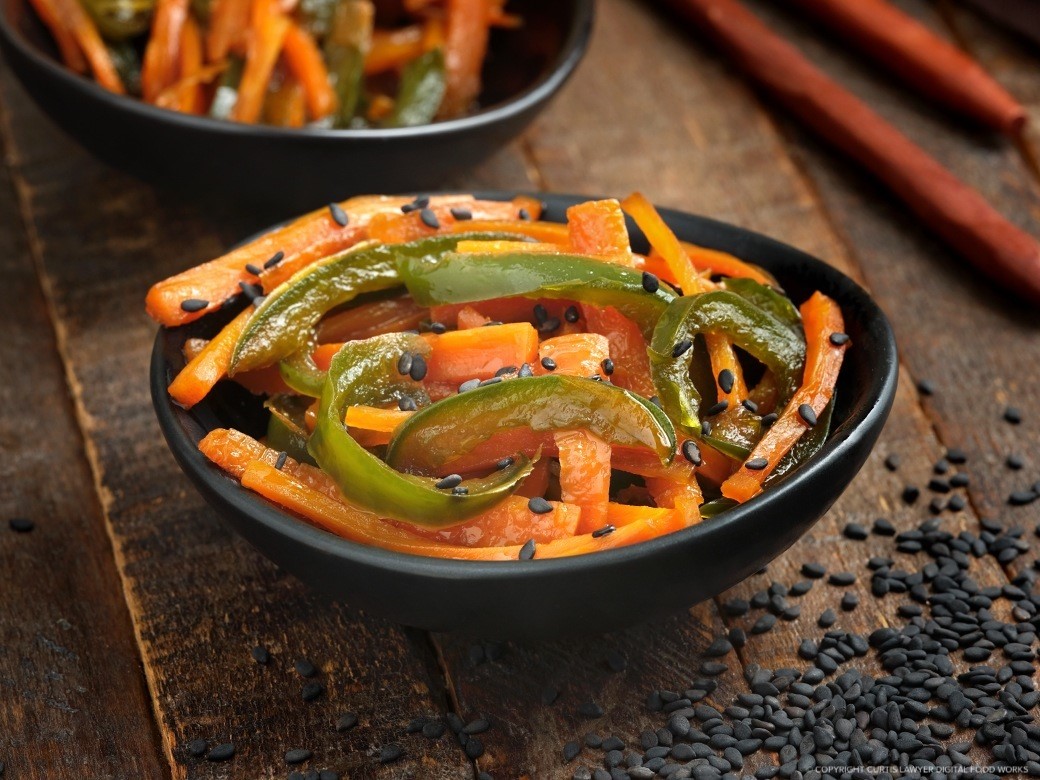Carrot and Pepper Kinpira Slaw
makes a great sandwich topper
10 min|Easy|Mild and Asian

Kinpira, is not really a "dish" that you eat, so much as it is a cooking style. Basically, it means "sauté and simmer". It's most often associated with Japanese style cooking, specifically, with root vegetables such as burdock and lotus root.
Since it's not always easy to find burdock and lotus roots at the grocery store, I tried out some Kinpira style cooking using carrots (technically, a root vegetable) and green peppers.
I was looking to add a little Asian flair to my "leftover turkey" sliders and this Carrot and Pepper Kinpira Slaw really did the trick! As a sandwich topper or a side dish — it tastes amazing!
Best of all, it all started out as a small-batch recipe — that can be done with something as small as one carrot and one half of a bell pepper, and easily scaled up from there!
Since it's not always easy to find burdock and lotus roots at the grocery store, I tried out some Kinpira style cooking using carrots (technically, a root vegetable) and green peppers.
I was looking to add a little Asian flair to my "leftover turkey" sliders and this Carrot and Pepper Kinpira Slaw really did the trick! As a sandwich topper or a side dish — it tastes amazing!
Best of all, it all started out as a small-batch recipe — that can be done with something as small as one carrot and one half of a bell pepper, and easily scaled up from there!
Ingredients
Step by Step Instructions
1
Cut the Veggies
Julienne the vegetables. (A julienne cut is like little matchsticks.)
2
Sautée First
Put the sesame oil in a small frying pan and set at medium-high heat. Once hot, add the carrots and stir-fry for 2 or 3 minutes. Add the peppers, and stir-fry for one additional minute.
3
Then Simmer
Add the dashi broth, soy sauce, sugar, and mirin — lower to medium, and simmer until the liquid is almost gone.
4
It's Done!
Remove the slaw from the heat and mix in some sesame seeds. If eating this as a warm side dish, it's ready to go. If you'll be using this as a sandwich topper, it can be added warm or cold.
Additional Notes

If you're curious about the flavor, this recipe really just adds a little Asian culinary flair to sautéed carrots and peppers. We mostly have the soy sauce and the dashi broth to thank for that.
An ingredient in this recipe you may not be familiar with is "Mirin".
Mirin is a thick, clear liquid that's a little sweet and a little tangy at the same time. It does have a fairly high alcohol content (around 15%) and by itself, tastes a little like rice wine… only it's way too thick to drink.
Mirin and Soy Sauce together, and reduced down, is basically Teriyaki sauce (there's usually some Sake in the mix too). The sugar content in the Mirin is what helps the Soy Sauce turn into a sticky Teriyaki glaze.
Because we still wanted to taste the freshness of our carrots and peppers in this slaw, a straight up Teriyaki glaze would be a little strong. So instead of using Sake as the main liquid in this Soy and Mirin glaze — dashi broth was used.
Dashi, is a traditional Japanese soup stock, that's used for all sorts of things from miso soup, to tempura dipping sauce.
There really isn't any "substitute" quite like Mirin, if you don't have any available. A dry white wine will work, but then you'll have to start adding sugar to mix in order the get the balance of flavor and stickiness correct. It's probably easier to just get a bottle of Mirin.
If your Mirin bottle has "Aji-Mirin" printed on the label, it's not 100% Mirin. "Aji" basically means "tastes like", so they've chemically upped the sugar content to save time and money. It's okay though… it's still balanced like an authentic Mirin, and it'll get the stickiness going.
An ingredient in this recipe you may not be familiar with is "Mirin".
Mirin is a thick, clear liquid that's a little sweet and a little tangy at the same time. It does have a fairly high alcohol content (around 15%) and by itself, tastes a little like rice wine… only it's way too thick to drink.
Mirin and Soy Sauce together, and reduced down, is basically Teriyaki sauce (there's usually some Sake in the mix too). The sugar content in the Mirin is what helps the Soy Sauce turn into a sticky Teriyaki glaze.
Because we still wanted to taste the freshness of our carrots and peppers in this slaw, a straight up Teriyaki glaze would be a little strong. So instead of using Sake as the main liquid in this Soy and Mirin glaze — dashi broth was used.
Dashi, is a traditional Japanese soup stock, that's used for all sorts of things from miso soup, to tempura dipping sauce.
There really isn't any "substitute" quite like Mirin, if you don't have any available. A dry white wine will work, but then you'll have to start adding sugar to mix in order the get the balance of flavor and stickiness correct. It's probably easier to just get a bottle of Mirin.
If your Mirin bottle has "Aji-Mirin" printed on the label, it's not 100% Mirin. "Aji" basically means "tastes like", so they've chemically upped the sugar content to save time and money. It's okay though… it's still balanced like an authentic Mirin, and it'll get the stickiness going.